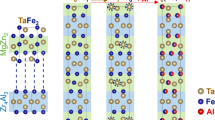Abstract
The authors investigated the effects of alloy content on mechanical properties to make clear a correlation between plastic deformation behavior and β-phase stability in Ti-Nb-Ta-Zr-O alloys. It was realized that there was specific compositional area in which the alloy exhibited little work hardening and minimum Young’s modulus value. The specific area was expressed by the bond order (Bo), based on theDV-Xα method, of 2.87 and the averaged electron/atom ratio (e/a) of 4.24, which corresponded to those of a multifunctional β titanium alloy, “Gum Metal.” These electronic conditions also minimized ideal strength required for plastic deformation without any dislocation activity. The deformation behavior of alloys in the specific compositional area revealed that the unique behavior could be characterized by a “giant fault.” It was also confirmed that such a compositional area corresponded to the phase boundary between the α″ martensite and β phases at room temperature.
Similar content being viewed by others
References
T. Saito, T. Furuta, J.H. Hwang, S. Kuramoto, K. Nishino, N. Suzuki, R. Chen, A. Yamada, K. Ito, Y. Seno, T. Nonaka, H. Ikehata, N. Nagasako, C. Iwamoto, Y. Ikuhara, and T. Sakuma, Multifunctional Alloys Obtained via a Dislocation-Free Plastic Deformation Mechanism,Science, Vol 300, 2003, p 464–467
T. Furuta, K. Nishino, J.H. Hwang, A. Yamada, K. Ito, S. Osawa, S. Kuramoto, N. Suzuki, R. Chen, and T. Saito, Development of Multi Functional Titanium Alloy, “Gum Metal”,Ti-2003 Science and Technology; Proceedings of 10th World Conference on Titanium, G. Lutjering and J. Albrecht, Ed., Jul 13–18, 2003 (Hamburg), Wiley, 2004, p 1519–1526
S. Kuramoto, T. Furuta, J.H. Hwang, Y. Seno, T. Nonaka, H. Ikehata, N. Nagasako, K. Nishino, T. Saito, C. Iwamoto, Y. Ikuhara, and T. Sakuma, Origin for “Super” Properties in GUM METAL,Ti-2003 Science and Technology; Proceedings of 10th World Conference on Titanium, G. Lutjering and J. Albrecht, Ed., Jul 13–18, 2003 (Hamburg), Wiley, 2004, p 1527–1534
M. Morinaga, N. Yukawa, T. Maya, K. Sone, and H. Adachi, Theoretical Design of Titanium Alloys,Sixth World Conference on Titanium, P. Lacombe, R. Tricot, and G. Beranger, Ed., Jun 6–9, 1988 (Cannes), Les Editions de Physique, 1989, p 1601–1606
S. Hanada, T. Yoshio, and O. Izumi, Effect of Plastic Deformation Modes on Tensile Properties of Beta Titanium Alloys,Trans. Jpn. Inst. Met., Vol 27, 1986, p 496–503
S. Hanada, M. Ozeki, and O. Izumi, Deformation Characteristics in β Phase Ti-Nb Alloys,Metall. Trans. A, Vol 16, 1985, p 789–795
H. Ikehata, N. Nagasako, T. Furuta, A. Fukumoto, K. Miwa, and T. Saito, First-Principles Calculations for Development of Low Elastic Modulus Ti Alloys,Phys. Rev. B, Vol 70, 2004, p 174113 (1–8)
C.R. Krenn, D. Roundy, J.W. Morris, Jr., and M.L. Cohen, Ideal Strength of bcc Metals,Mater. Sci. Eng., Vol A319–321, 2001, p 111–114
Author information
Authors and Affiliations
Rights and permissions
About this article
Cite this article
Hwang, J., Kuramoto, S., Furuta, T. et al. Phase-stability dependence of plastic deformation behavior in Ti-Nb-Ta-Zr-O alloys. J. of Materi Eng and Perform 14, 747–754 (2005). https://doi.org/10.1361/105994905X75556
Received:
Published:
Issue Date:
DOI: https://doi.org/10.1361/105994905X75556




